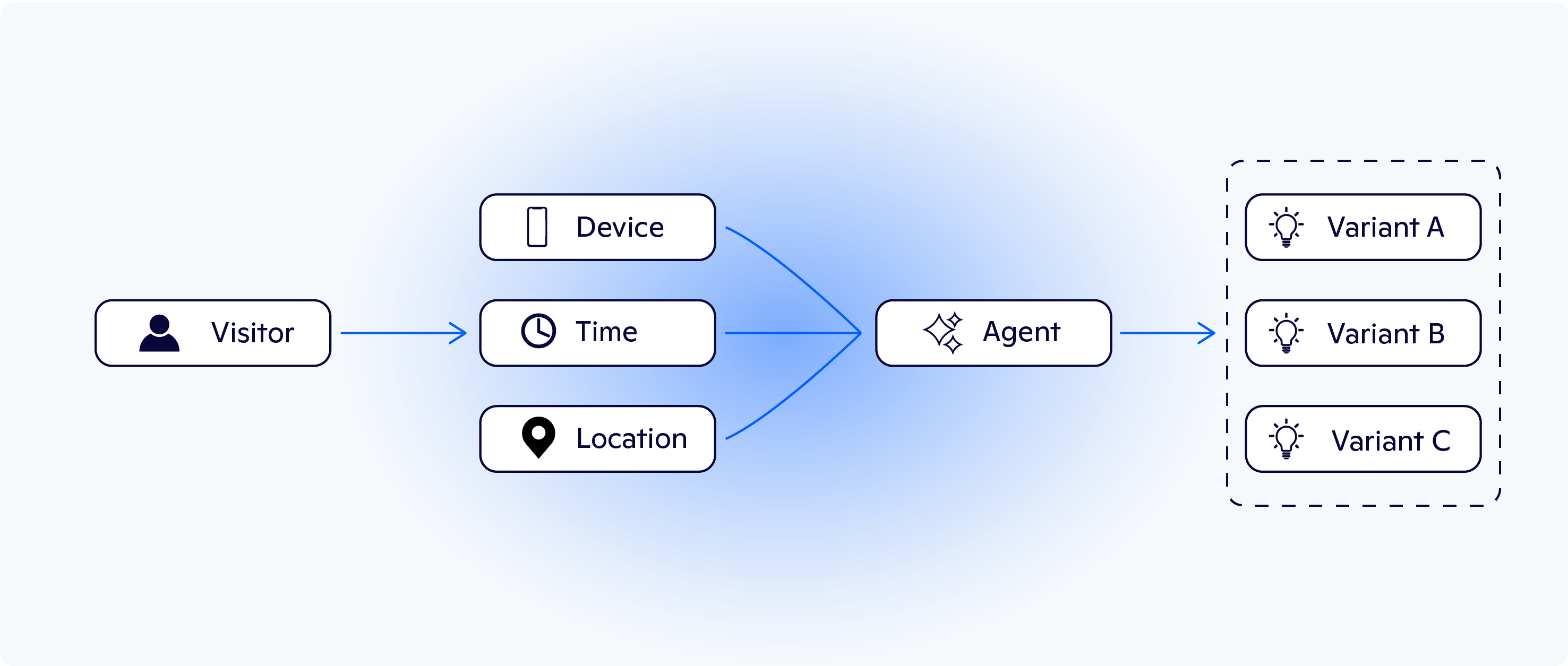In digital marketing, pressure is the default. You're expected to hit your numbers, launch the next campaign, and somehow know what your audience needs before they do. A/B testing has long been the safety net. A way to reduce guesswork and validate decisions.
But from my seat in data science, working with marketers every day, I’ve seen something shift. In today’s fast-moving environment, behavior can change before a test finishes running. By the time you reach significance, the moment has passed. The “winner” is already losing.
That’s why we started asking a different question:
What if you didn’t have to wait? What if your site could learn and adapt in real time?
That’s the promise of agentic personalization. Powered by AI, it doesn’t just analyze, it acts. Think of it as replacing a static optimization tool with a tireless, digital expert that adjusts its pitch for every visitor, every time.
Let me show you what that unlocks.
The Familiar Friend: The Pros and Cons of A/B testing
A/B testing is straightforward and valuable. You create two or more versions of a webpage, email, or ad (Variant A, Variant B, etc.), show them to different segments of your audience, and after a statistically significant period, you crown the winner. It offers concrete evidence of what works best on average.
However, the very process of traditional A/B testing has inherent limitations that can quietly eat into your potential revenue:
The waiting game: You know the drill: run the test, wait for significance, hope it works. In the meantime, you're knowingly sending half your visitors to a version that might underperform. When you're running a high-stakes promo or trying to close end-of-quarter pipeline, that's painful.
The "one-size-fits-all" winner: Your test picks a winner, but it flattens nuance. What if Variant A is a knockout with first-time visitors from Instagram, while Variant B resonates better with returning newsletter subscribers? A/B testing smooths over these crucial nuances and declares a single “best,” even if it’s not the best for everyone.
A snapshot in time: You finally get results…from two weeks ago. In that time, your audience may have shifted, a competitor may have dropped a better offer, or your hero product just started trending on TikTok. And you're still showing what “won” in last week's test.
The Future is Here: Agentic Personalization
That’s why we started exploring a different approach that could help our customers adapt in real time. We’re not trying to replace A/B testing altogether, but rather solve a recurring problem: how can marketers move faster and with greater precision when customer behavior won’t sit still?
Our answer is agentic personalization. It replaces fixed test windows with continuous learning and decision-making. Powered by a mechanism called reinforcement learning, this AI-driven approach doesn’t just find one winner. It identifies the best variant for each individual visitor based on their context.
Think of it like a great salesperson. They don’t deliver the same pitch to everyone. They observe, adapt, and personalize based on who they’re talking to. That’s the model we followed.
How it Works
So how does agentic personalization actually work?
The concept is simple, even if the math behind it isn’t: you feed the system a set of variants (e.g., different headlines, images, offers) and it learns, in real time, which one is most likely to convert for each individual visitor.

The agent evaluates visitor context, like device, time, and location, to deliver
the version most likely to convert.
What kind of device they’re using (mobile or desktop)
What time of day they landed on your site
Where they’re located
Whether they’ve been here before
How they got to you (ad, email, search, etc.)
But it doesn’t stop there. It compares this context to patterns it’s seen before (e.g., what worked for similar visitors) and chooses the version that’s most likely to resonate.
Moreover, when someone converts, the system gets smarter. That “reinforcement” helps it make even better decisions for the next person. No waiting. No manual adjustments. Just constant learning, baked in.
In other words, you’re not just testing variations, you’re teaching your site to get better with every visit.
The Bottom Line: Key Advantages of an Agentic Approach
When we tested this approach across multiple customer environments, three key benefits consistently stood out:
Starts generating revenue immediately: There's no waiting period where you knowingly show underperforming versions just to get data. The agent starts optimizing immediately. This is a game-changer for time-sensitive promotions, like a holiday sale or a seasonal campaign, where every visitor counts.
Makes personalization truly personal: This goes beyond finding the "best for the average." With agentic personalization, every visitor gets the experience most likely to resonate, with no rules or guesswork required.
Adapts on the fly: If a particular product suddenly starts trending on social media, the agent picks up on it and adjusts instantly. There’s no need to rerun tests or wait for weekly reports. It just works, in real time.
Lets you add new ideas on the fly: No need to restart the test or wait for significance. Just drop in a new variant, like a fresh headline or offer, and the agent will automatically start learning who it works for. The test keeps running, the optimization keeps improving.
It's Not a Competition, It's an Evolution
A/B testing still has its place, especially when you need clean, statistically sound answers to inform big decisions, like a website overhaul. But when the job is to drive conversions, stay relevant, and grow in real time, you need something faster and more responsive.
Marketers don’t need more tests, they need better outcomes. The real challenge isn’t a lack of data or tools. It’s a lack of systems that can learn and adapt without manual workarounds or weeks of waiting.
That’s exactly why we built agentic personalization. This approach doesn’t just improve performance. It keeps you in sync with your customers, in real time, at scale, without the wait.
Because if you’re still optimizing for what worked yesterday, you’re already behind.
Want to see how agentic personalization works in real life? Request a demo today.






